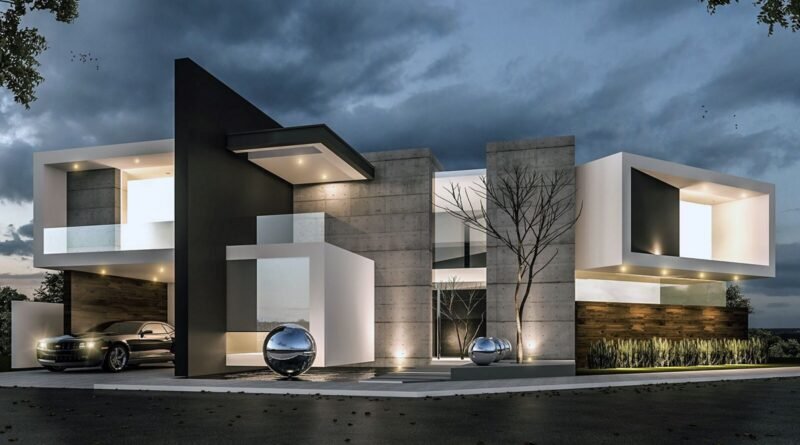10 Best Front Home Design Ideas
Are you confused about which best front home design will make both aesthetic and useful outside your home? Well, we are here to give clarity to which front home design to suggest the best designs. Choosing the right front home design has to select your chosen bean, financial obstacles and suitable hues, texture, form, and landscape accents with site. In addition to reflecting your taste and personality, a well -designed front entrance can curb your home comfort, curb the appeal and increase the price. In this post, we will check some of the most recent trends and the best front home design for your home.
Table of Contents
Best Front Home Designs
1. Wooden front home design
2. Modern front home design
3. 3D front home design
4. Glass front home design
5. Metal & Stone front home design
6. Color & Texture front home design
7. Brick front home design
8. Cottage front home design
9. Colonial front home design
10. Slanted Concrete front home design
1. Wooden Front Home Design
The use of natural wood as the primary material for the exterior of a house is known as the “design of the front house of wood”. It can produce an exquisite, rustic and warm beauty that goes well with the environment. Pine, cedar, oak, teak, and so on, different types of wood species, can be used to design the front part of your house. It can be designed in various ways including traditional, modern, contemporary and classic.
The architectural elements of the house, such as doors, windows, roof and its size shape, form and color, can also be reflected in style. Different types of finish including paint, stains, varnishes or oils can be applied. Treatment can bring some personality and personality to the house, preserving the underlying beauty of wood and preserving it with fungi, insects and weathering. It can be mixed and matched with various materials such as glass, metal, stone or brick.

2. Modern Front Home Design
The external style and appearance of a house, especially its front appearance, is known as its “modern front home design”. The use of large windows, geometric shapes, clean lines and a variety of materials like glass, metal, stone and wood is characterized by modern front height design. In addition, the best modern Indian front wall is ensured to give a modern approach in addition to tiles.
In addition, to add visual interest and balance, they may have contrasting finish, texture and huge. There are some examples of porches, balconies, courtyards, and roofs open and attached areas that can be combined to create outdoor life and entertaining features. In addition, the modern front elevation design can increase home curb appeal and price. In addition, they can reduce the requirement of artificial light and cooling by bringing natural light and ventilation into internal spaces. They can provide a comfortable and fashionable living space that catches the personality and essence of the manner of the owners.

3. 3D Front Home Design
The practice of employing 3D techniques to create realistic and attractive pictures of the front of a building is known as the 3D front home design. It gives a unique appearance from your home, different approaches and angles. You can choose various 3D models with the help of software tools you want to apply for your home. This 3D design lets you show your home or structure to potential tenants, investors, or buyers and dazzle them with your originality and vision.
It makes you feel happy with your work and gives you more confidence and satisfaction with your home or project. The 3D front elevation structure is different from other designs as they tolerate separate geometric 3D structures that can give the house a better view.
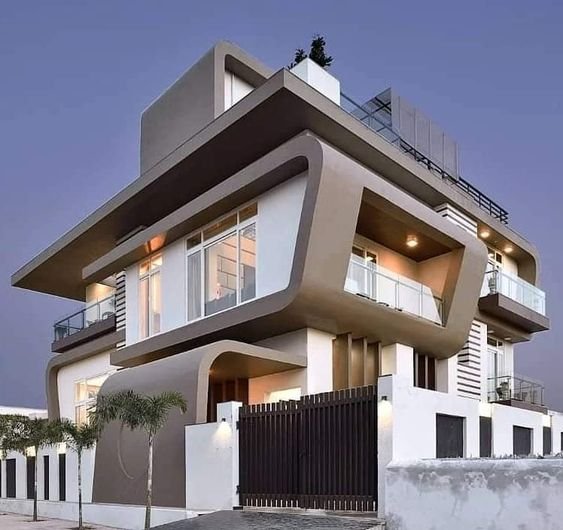
4. Glass Front Home Design
Glass front elevation designs characterize the architecture of giant windows or glass walls that allow them to go to natural light and provide expansionary views of the surrounding area. Glass can be tinted, frastered, cleared or pattern to obtain various privacy degrees and effects. The choice of frame or no frame for glass will depend on structural design and aesthetics. To offer insulation and soundproofing, the glass can have one, two or three pans.
It is possible to have fixed or movable glass, which allows access to outer areas and ventilation. This glass-fraunt elevation design style gives an openness and vast impression using wide windows or glass walls, making the house feel large and more integrated with the environment. It also reduces the need for artificial light and heating, which increases the stability and energy efficiency of the house. Finally, it connects the joy and value of the house by providing breathtaking, unhealthy views of the surrounding area, city or lake.
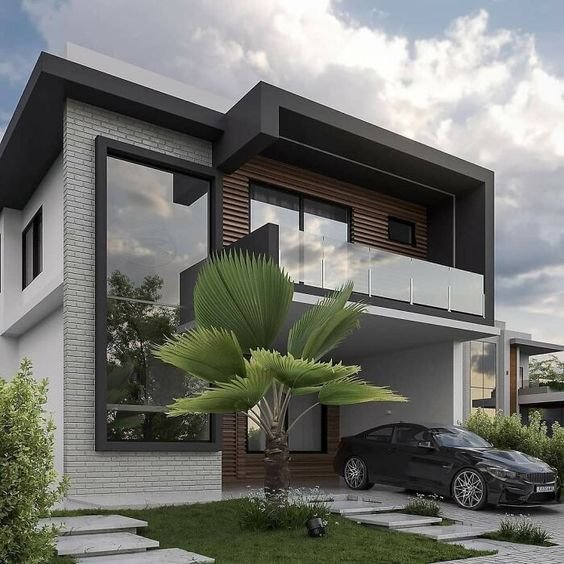
5. Metal & Stone Front Home Design
Stone front and metal elevation design is a type of design that gives your home a smooth and contemporary exterior by mixing the use of stone and metal elements. Real stone siding that gives your home a touch of natural beauty and texture. Your property can benefit from the durability of stone siding and insulating properties. Metal accents or siding that are contrasting with stone to modernity and industry to provide an air. Additionally, the siding of the metal can reflect heat and light, which increases the energy efficiency of your home.
Large metal-frame windows that allow your home to go into natural light and ventilation. Additionally, Windows can improve the appeal to curb your home and provide picturesque views of your surroundings. Its energy-efficient and environmentally friendly design can reduce your utility cost and affect the environment. Additionally, the humidity and temperature of your home, stone and metal materials can reduce the requirement of artificial heat and cooling capable of controlling the temperature.

6. Color & Texture Front Home Design
This type of design employs various hues and textures to give your home a specific and eye -catching external appearance. Too. This lets you personalize the exterior of your house to fit your taste in architecture, style and value range. In addition, because it can bring harmony, balance and vice versa for many components in front of the House, this design can improve your home curb appeal, price and personality.
This style has the advantage of helping your home stand out of others in the neighborhood. You can use your home to represent your identity, taste and way of life by choosing a specific and artistic design. The capacity of this style is another benefit to mix with the natural environment and climate of your location. In addition, this design can mold your home to wear and tear and weather damage. If you use high quality, prolonged ingredients, your home may last long and require little maintenance.
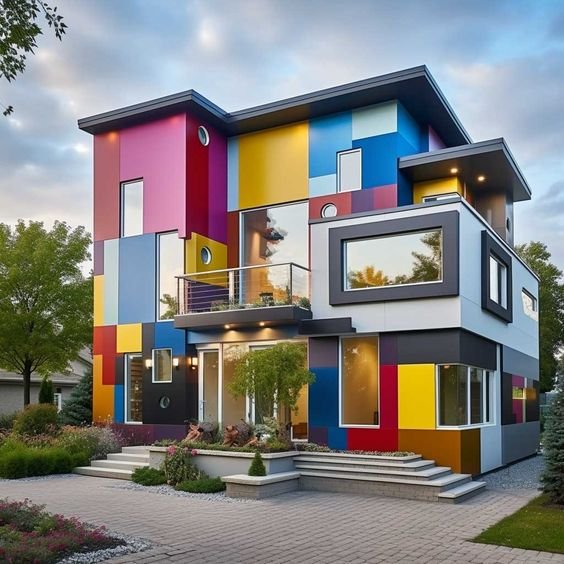
7. Brick Front Home Design
Brick brick front elevation design is the primary material used for the exterior of a house in architectural style. Like the brick used, color, patterns and textures can determine the characteristics and specifications of a brick front home. This style can be best suitable for your home because it has many benefits. Since brick is low maintenance, fire-resistant and long lasting, it can save money and increase the value of the house.
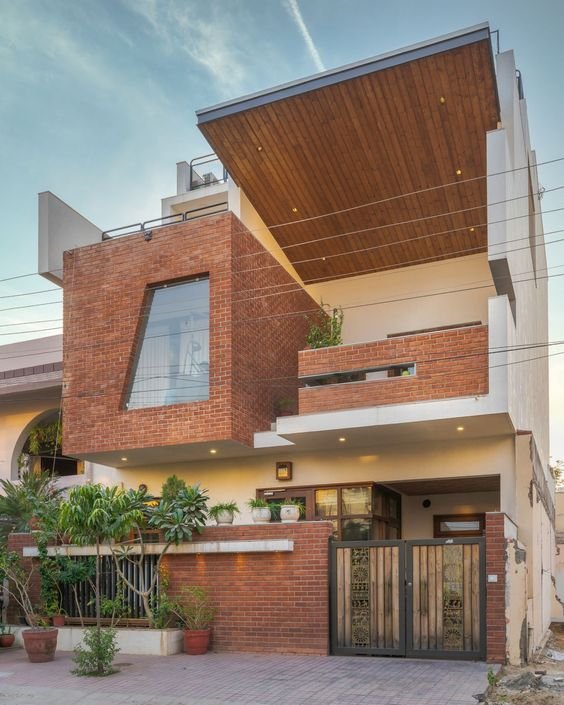
8. Cottage Front Home Design
Cottage-style is one of the best front home design ideas that provide a connection and a laid-back lifestyle to nature that is attractive and comfortable. Families searching for a warm home that balance between comfort and simplicity will like them. They offer a great deal of character and attraction with a more compact and effective footprint, which make them perfect for those individuals who are downsizing.
This cottage front elevation design is well mixed with several settings, including lakes, forests, beaches and mountains, producing a pleasant and picturesque vision. Another advantage is that it improves the stability and environmentality of the house by maintaining a well-combination and beauty of the region with a natural surroundings. In addition, the cottage-front home design gives residents a warm and invited living area that is simple to maintain and personalize, allowing them to demonstrate their interests and personalities.

9. Colonial Front Home Design
The colonists coming to America in the 17th and 18th centuries are credited with creating a architectural style known as the design of the colonial front house. It has a simple, rectangular, symmetric shape with closed windows, a central front doors and other characteristics. The front porch, or portico, which gives a warm touch and shade to the entrance and is often supported by columns, is one of the most distinguished elements of colonial front home design. To increase the amount of light and location in the upper stories, there are also dormer windows in the house that spread from the roof.
A side gable roof slopes on both sides of the house and forms a triangle at the ends. A brick chimney, or chimney, provides a traditional and bizarre touch to the building. It is usually made of stone, brick, or clapboard, an attractive and long -lasting appearance outside the house. In addition, it is a classic and adaptable form that can adjust many types of tilt. Due to its direct geometry, which promotes compatibility and flexibility, it is easy to expand and change with extensions and restoration.

10. Slanted Concrete Front Home Design
A type of architecture, known as a “slanted concrete front home design”, has a pitch or sloping roof that extends to the front of the building, giving it a smooth, contemporary appearance. The desired structural performance and appearance can be made from concrete, metal, or wood, which can be made from concrete, metal or wood, one of the primary features of the design of the front house of concrete.
The house can be attached to a geometric shape, the weather can offer privacy and shelter, which is by converting the roof into a wall. In addition, you can use some best height tips to increase the appearance of the overall front home. Because the roof line follows the path of the sun or the slope of the land, a oblique roof can also give a mark of movement and openness. In addition, because the sited roof suiting location and customer preferences can be shaped in many ways, it can also provide additional flexibility and creativity in the design of the house.
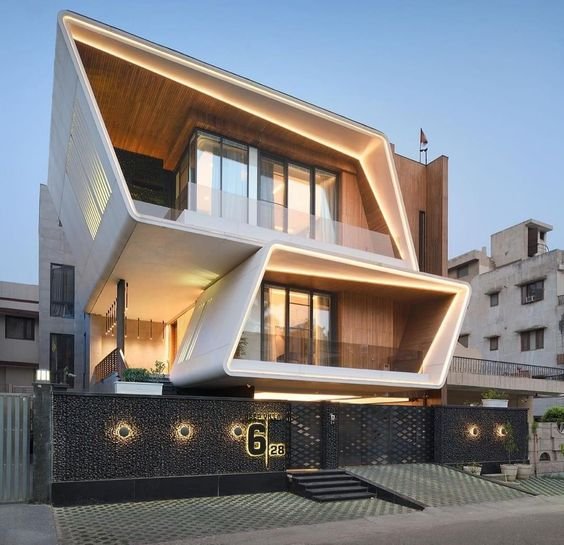
Also read: 7 Best Villa Interior Design Ideas

